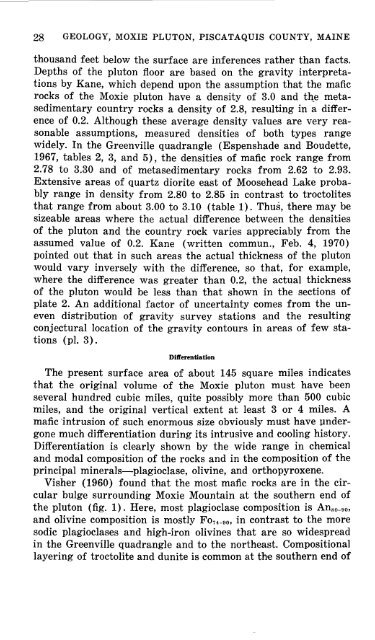Geology Of The Moxie Pluton In The Moosehead
Geology Of The Moxie Pluton In The Moosehead
Geology Of The Moxie Pluton In The Moosehead
Create successful ePaper yourself
Turn your PDF publications into a flip-book with our unique Google optimized e-Paper software.
28 GEOLOGY, MOXIE PLUTON, PISCATAQUIS COUNTY, MAINE<br />
thousand feet below the surface are inferences rather than facts.<br />
Depths of the pluton floor are based on the gravity interpretations<br />
by Kane, which depend upon the assumption that the mafic<br />
rocks of the <strong>Moxie</strong> pluton have a density of 3.0 and the metasedimentary<br />
country rocks a density of 2.8, resulting in a difference<br />
of 0.2. Although these average density values are very reasonable<br />
assumptions, measured densities of both types range<br />
widely. <strong>In</strong> the Greenville quadrangle (Espenshade and Boudette,<br />
1967, tables 2, 3, and 5), the densities of mafic rock range from<br />
2.78 to 3.30 and of metasedimentary rocks from 2.62 to 2.93.<br />
Extensive areas of quartz diorite east of <strong>Moosehead</strong> Lake probably<br />
range in density from 2.80 to 2.85 in contrast to troctolites<br />
that range from about 3.00 to 3.10 (table 1). Thus, there may be<br />
sizeable areas where the actual difference between the densities<br />
of the pluton and the country rock varies appreciably from the<br />
assumed value of 0.2. Kane (written commun., Feb. 4, 1970)<br />
pointed out that in such areas the actual thickness of the pluton<br />
would vary inversely with the difference, so that, for example,<br />
where the difference was greater than 0.2, the actual thickness<br />
of the pluton would be less than that shown in the sections of<br />
plate 2. An additional factor of uncertainty comes from the uneven<br />
distribution of gravity survey stations and the resulting<br />
conjectural location of the gravity contours in areas of few stations<br />
(pl. 3).<br />
Differentiation<br />
<strong>The</strong> present surface area of about 145 square miles indicates<br />
that the original volume of the <strong>Moxie</strong> pluton must have been<br />
several hundred cubic miles, quite possibly more than 500 cubic<br />
miles, and the original vertical extent at least 3 or 4 miles. A<br />
mafic 'intrusion of such enormous size obviously must have undergone<br />
much differentiation during its intrusive and cooling history.<br />
Differentiation is clearly shown by the wide range in chemical<br />
and modal composition of the rocks and in the composition of the<br />
principal minerals-plagioclase, olivine, and orthopyroxene.<br />
Visher (1960) found that the most mafic rocks are in the circular<br />
bulge surrounding <strong>Moxie</strong> Mountain at the southern end of<br />
the pluton (fig. 1). Here, most plagioclase composition is Anso-9o,<br />
and olivine composition is mostly Foi4-9o, in contrast to the more<br />
sodic plagioclases and high-iron olivines that are so widespread<br />
in the Greenville quadrangle and to the northeast. Compositional<br />
layering of troctolite and dunite is common at the southern end of

















